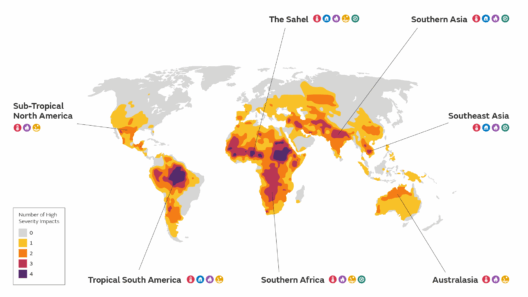Coral reefs, often referred to as the “rainforests of the sea,” are cradles of biodiversity, teeming with an array of marine life. However, these vibrant ecosystems are currently facing an unprecedented crisis due to the scourge of global warming. The phenomenon of coral bleaching exemplifies the perilous impact of climate change, underscoring the urgent need for awareness and action.
At the heart of this ecological tragedy lies the delicate symbiosis between coral polyps and the microscopic algae known as zooxanthellae. These tiny organisms provide corals with their stunning colors and are essential in facilitating photosynthesis, thereby supplying nutrients essential for coral health. This relationship is akin to a vibrant tapestry, where every thread represents a unique species contributing to the overall majesty of the reef. When conditions become unfavorable—most notably, rising sea temperatures—this intricate tapestry begins to unravel.
Coral bleaching occurs when stressed corals expel their symbiotic algae, leading to a stark whitening effect that leaves them vulnerably exposed. This process parallels the sudden loss of color in a painting left to fade in the relentless sun. Without the algae’s photosynthetic input, corals struggle for survival, becoming susceptible to disease and ultimately, death. Ironically, even a rise in temperature of just 1 to 2 degrees Celsius can provoke this devastating response, revealing the fragility of these ecosystems.
The crisis of coral bleaching does not merely impact coral populations; it reverberates through the marine environment, influencing a myriad of species. Reefs provide habitat and nursery grounds for a multitude of fish species, crustaceans, and mollusks, serving as a critical foundation in the complex food web of the ocean. The loss of coral not only decimates biodiversity but risks destabilizing the entire marine ecosystem, leading to declines in fish populations and the livelihoods of communities that depend on fishing. The effect is akin to a house of cards, where the removal of a single card can lead to total collapse.
Moreover, coral reefs also play an integral role in coastal protection. Healthy reefs act as natural barriers, absorbing wave energy and reducing the impact of storm surges, thereby safeguarding coastal communities from the ravages of climate-induced phenomena such as hurricanes and tsunamis. The loss of these natural fortifications exacerbates the vulnerability of coastlines, making them prime targets for erosion and inundation. Consequently, the degradation of coral reefs poses a dual threat: jeopardizing marine life and increasing human suffering from climate-related disasters.
In the realm of tourism, coral reefs are an irreplaceable asset, attracting millions of visitors each year who contribute to local economies. Snorkeling and diving in crystal-clear waters among the magnificence of colorful corals is an experience that remains etched in memory. However, as bleaching events become more frequent and severe, the allure of these underwater paradises diminishes, leading to a decline in tourist numbers. The economic repercussions can be dire, affecting not only local businesses but also national economies reliant on marine tourism.
In recent years, there have been glimmers of hope amid the bleak scenario. Efforts to restore and protect coral reefs are emerging globally. Innovative techniques such as coral gardening, which involves cultivating corals in nurseries before transplanting them back into the wild, demonstrate promising potential. These initiatives not only enhance the resilience of coral to climate change but also foster community engagement and scientific collaboration. Such efforts are reminiscent of beacons of light in an otherwise dark landscape, signifying the possibility of rejuvenation and recovery.
Furthermore, the importance of reducing carbon emissions cannot be overstated. Transitioning towards renewable energy sources, promoting sustainable fishing practices, and advocating for stronger marine protection policies are all instrumental in mitigating the impacts of climate change. Each individual possesses a role in this collective endeavor; even the smallest actions, such as reducing plastic use and supporting conservation organizations, can contribute to larger movements aimed at coral reef preservation.
Education plays a pivotal role in raising awareness about the plight of coral reefs. By disseminating knowledge about the ecological importance of these systems and the challenges they face, we empower individuals to become stewards of the oceans. Informative initiatives that engage communities and enhance understanding highlight the interconnectedness of all marine life and the profound impact of human behavior on the health of the planet.
As we confront the realities of climate change, the fate of coral reefs symbolizes the broader struggle facing our oceans. It challenges us to reflect on the urgency of our actions and their consequences. The metaphor of coral reefs serves as a poignant reminder: fragile and beautiful, they exemplify the intricate balance of nature. If we do not act now to protect these vital ecosystems, we risk silencing a cacophony of life that has thrived for eons, leaving behind a world that echoes with the absence of color and vitality. This is a clarion call: time is running out, and the revival of coral reefs is contingent upon collective action in response to the existential threat of global warming.
In conclusion, the saga of coral reefs is one of both tragedy and potential. The battle against global warming’s bleaching threat must be fought on multiple fronts, from grassroots initiatives to international policies. It is an all-hands-on-deck scenario where humanity’s innovative spirit can shine brightly against the backdrop of climate adversity. The reverberations of our choices today will echo through generations; thus, we must act with both conviction and urgency to ensure that coral reefs don’t merely survive, but thrive, continuing to dazzle the world with their unparalleled beauty.






